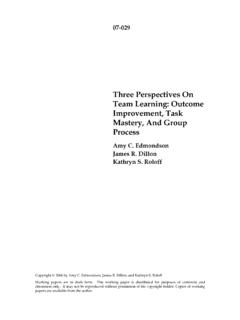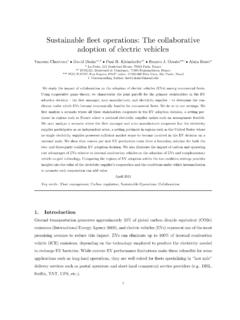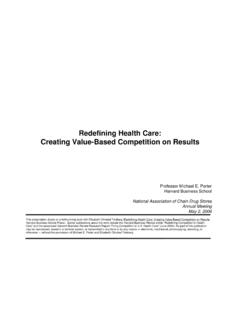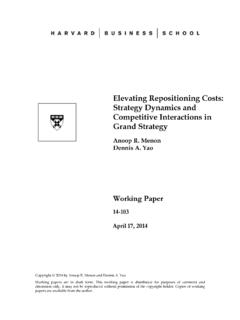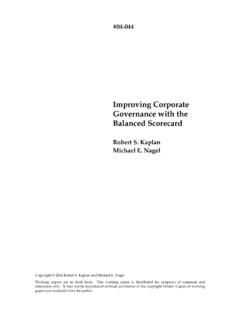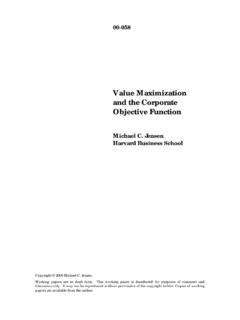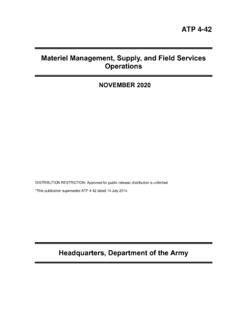Transcription of Sustainable Supply Chains - Harvard Business School
1 Extension and Outreach Sustainable Supply Chains : A Guide for Small- to Medium-sized ManufacturersJennifer BlackhurstCollege of Business , Iowa State UniversityDave CantorCollege of Business , Iowa State UniversityMike O DonnellCIRAS, Iowa State University iiSustainable Supply Chains : A Guide for Small- to Medium-sized ManufacturersThe Center for Industrial Research and Service (CIRAS) provides applied research, education, and technical assistance to Iowa industry through partnerships with Iowa s universities, community colleges, and government agencies. Assistance is supported in part by the DoC/NIST Hollings Manufacturing Extension Partnership, the DoD/DLA Procurement Technical Assistance Program, the DoC/EDA University Center Program, and the USDA BioPreferred report was prepared under awards from the Department of Commerce, Economic Development Administration and the National Institute for Standards and Technology, Hollings Manufacturing Extension publication was prepared by the Center for Industrial Research and Service.
2 The statements, findings, conclusions, and recommendations are those of the author(s) and do not necessarily reflect the views of the Department of Commerce. 2012, Iowa State University Extension. All Rights Supply Chains : A Guide for Small- to Medium-sized Manufacturers Table of ContentsCurrent State of Supply Chain Sustainability: A Benchmarking Report .. Chain Sustainability: An Introduction ..2 Defining Sustainability: Triple Bottom Line Approach ..3 The Triple Bottom Line and Stakeholders ..3 Examples of Supply Chain Sustainability in Business ..6 Lessons from Industry Reports ..6 Sustainability within SMEs ..8 Synthesizing the Chain Sustainability: Roadmap for Implementation ..11 References ..13 Appendix A: Examples of Sustainability Initiatives ..15 Appendix B: Supply Chain Sustainability Assessment for SMEs ..29 Appendix C: Sustainability Standards ..331 Sustainable Supply Chains : A Guide for Small- to Medium-sized ManufacturersSummaryThe goal of this report is to provide small- to medium-sized enterprises (SMEs) with the tools and knowledge to begin making changes to their Business that benefit the triple bottom line financial, social, and environmental success.
3 This is accomplished through a review of academic research, industry best practices, and lessons learned by the authors in working with chain sustainability is a topic of increasing importance for businesses and can be of particular interest to SMEs. A recent survey suggests 30% of manufacturers are gaining new profits directly from sustainability initiatives, showing a clear opportunity for bottom-line results by implementing sustainability. In this report, the concept of Supply chain sustainability and its importance in today s environment is introduced. The idea of the triple bottom line as the foundation of sustainability is report highlights the importance of Supply chain sustainability from a Business perspective and discusses findings from recent surveys on the benefits and challenges of Supply chain sustainability. It then focuses on SMEs in particular and how they may use the concept of Supply chain sustainability to their competitive advantage.
4 Finally, a roadmap for developing excellence and expertise in Supply chain sustainability is presented and a tool for benchmarking and current state analysis is State of Supply Chain Sustainability: A Benchmarking Report2 Sustainable Supply Chains : A Guide for Small- to Medium-sized ManufacturersSupply Chain Sustainability: An Introduction The issue of sustainability in Supply chain management is gaining attention in both academic literature and industry practice as an area of opportunity. Companies across geographic and industry boundaries are implementing sustainability initiatives in the Supply chain in response to pressures from consumers, regions of operation, investors, and even employees. Melnyk, Davis, Spekman, and Sandor (2010) state that Supply Chains must be designed and managed to deliver certain outcomes sustainability being one of these outcomes that are driven by customer needs.
5 Sustainability may be driven from within the company or may, in part, be the result of customer needs and pressures as well as other Supply chain partners such as suppliers and local and federal governments. One of the key aspects of sustainability is the holistic view that is applied in understanding the total impacts of products and services and focusing improvements on areas with the most impact. This approach encompasses both the entire life cycle of a product or service and the entire Supply chain of that service. Therefore, when businesses address sustainability, it is usually insufficient to simply address sustainability initiatives within the walls of the company. In order to pursue sustainability initiatives with the most potential Business impact, companies must look beyond the borders of their Business . Therefore, throughout this report, Supply chain sustainability as the overall approach to implementing sustainability is addressed, including the Supply base, internal operations, and customer report will Define the scope, importance, and impact of Sustainable Supply Chains ; Discuss the importance and opportunities for SMEs to implement Sustainable Supply chain practices; and Develop a high-level roadmap for Supply chain of a Supply ChainA Supply chain is the material, information, and services, typically crossing several different organizations, involved in producing and delivering a product or service to an end user.
6 Supply chain management is a total systems approach to managing the entire flow of information, materials, and services from raw-material suppliers through factories and warehouses to the end customer. In fact, some scholars argue that firm survival in the modern Business environment is no longer an issue of one firm competing against another firm but has, instead, become an issue of one Supply chain competing against another Supply chain (Fine 1998).3 Sustainable Supply Chains : A Guide for Small- to Medium-sized ManufacturersDefining Sustainability: Triple Bottom Line ApproachA Sustainable Supply chain is one that includes measures of profit and loss as well as social and environmental dimensions (Carter and Rogers 2008; Linton, Klassen, and Jayaraman 2007). Such a conceptualization has been referred to as the triple bottom line financial, social, and environmental performance (Elkington 1994, 1998; Kleindorfer, Singhal, and Wassenhove 2005).
7 The use of triple bottom line is adopted in this report as the definition of sustainability. Carter and Rogers (2008) state that the triple bottom line is the intersection of social, environmental, and financial performance, as shown in Figure 1. Therefore, for a company to pursue sustainability they cannot pursue financial or social initiatives in a vacuum. Instead, it is strongly recommended that Supply chain managers link environmental, social, and financial goals within a broader strategy to ensure the Business pursues sustainability rather than philanthropy. Business success can no longer be measured by only financial performance, as other aspects are critical to long-term success. Researchers such as Markley and Davis (2007) discuss how businesses should not just be measured by traditional financial measures, but also by their social/ethical and environmental performance. These concepts revolve around the idea that companies managed and evaluated using the triple bottom line may have a better likelihood of long-term Triple Bottom Line and StakeholdersRecent research has shown that implementing triple bottom line initiatives is largely in response to growing pressure on businesses to pay more attention to the environmental and resource consequences of their operations.
8 This pressure comes from a variety of groups including stakeholders, government regulations, nongovernment organizations, and competitors (Dai and Blackhurst 2011; Sarkis 1998). This presents an added complexity in implementing sustainability within the Supply chain. Historically, Business initiatives (such as total quality management, lean manufacturing, and others) require relatively minimal stakeholder input, as these initiatives are profit motivated. However, the inclusion of the triple bottom line, by definition, brings in additional stakeholders who focus on the financial, social, and environmental impacts of the effort pays back in terms of profit. Consumers are willing to pay substantially more for goods produced based on triple bottom line, and consumers will also punish producers for Figure 1. Sustainability as defined by the triple bottom line (Carter and Rogers 2008)EnvironmentalPerformanceSustainabil itySocialPerformanceFinancialPerformance 4 Sustainable Supply Chains : A Guide for Small- to Medium-sized Manufacturersunethically produced goods (Trudel and Cotte 2009).
9 However, the story does not end there. The negative impact of unethically produced goods is greater than the positive impact of ethically produced goods. Consumers will, in fact, pay more for ethically produced goods, but if the goods are unethically produced, consumers will only purchase them at a substantial discount. This highlights not only the benefits of sustainability but the need to market or advertise these activities to various stakeholders in the Supply chain, including (of course) the end customer. This is supported in academic research as well. For example, Krause, Vachon, and Klassen (2009) state that businesses that emphasize sustainability as a competitive priority will benefit by communicating sustainability efforts to customers. Many experts are predicting that Sustainable Supply chain operations will, in fact, become an integral part of Supply chain strategy and operations.
10 The tools and concepts discussed in this paper will become part of daily Business and tie directly into performance. In a recent Deloitte Consulting report, the tie between Sustainable Supply chain management and cost savings was specifically addressed. In the report, it was stated that while many organizations have traditionally focused on their internal operations for cost reduction initiatives, businesses should not ignore the massive savings opportunities in the Supply chain. Leading businesses recognize that this goes beyond demanding cost cutting from their suppliers but re-looking at their Supply chain and focusing on reducing use and production of five metrics that are ubiquitous within it energy, carbon, water, materials and waste. Applying the triple bottom line concept across the Supply chain can lead to significant financial benefits. The United Nations Global Compact (2010) discusses how sustainability in the Supply chain is driven by Business needs specifically, (1) managing risks (risks that are environmental, social, and financial in nature), (2) realizing efficiencies (such as reduction in cost for materials, labor, energy, and transportation), and (3) creating Sustainable production (which can meet the needs of all stakeholders including government, customers, and suppliers).
